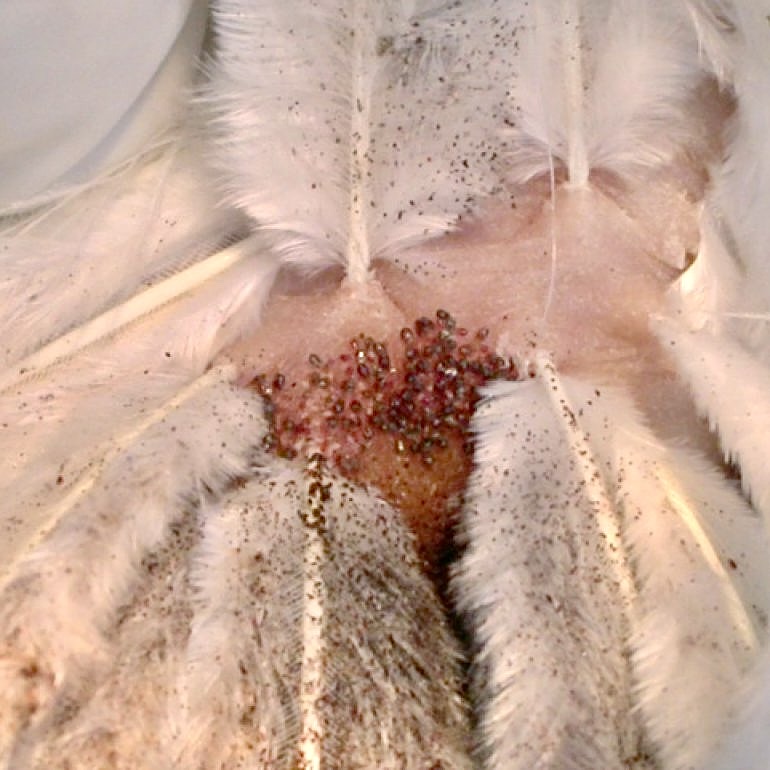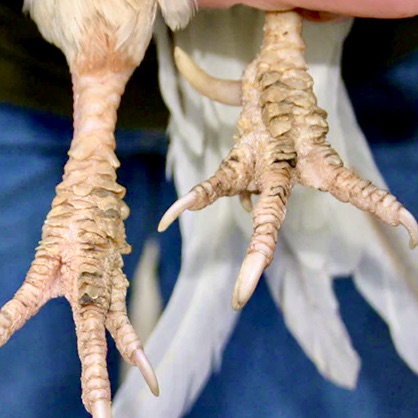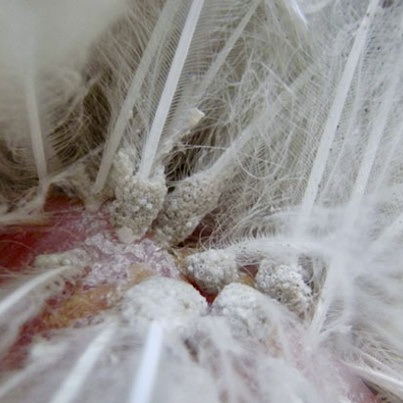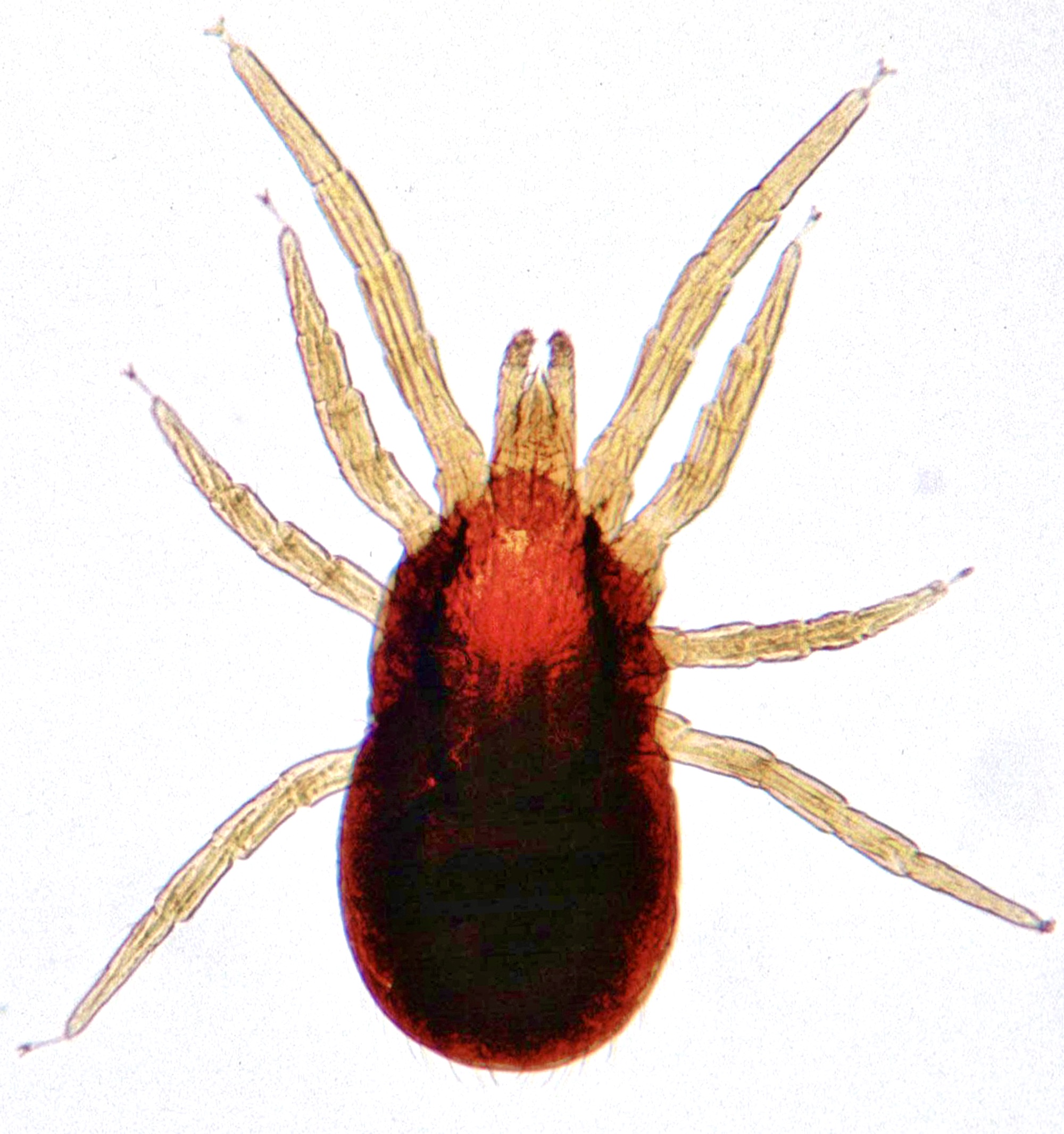Mites + Lice in Chickens
Poultry lice and mites are a natural part of life when it comes to keeping backyard chickens. These ectoparasites, or external parasites, are typically carried by birds, rodents, and other wildlife, also known as hosts. If any hosts are regularly visiting your chicken coop and run, it is likely that there are also mites and/or lice as well. It is important to be able to identify the parasite that is causing the infestation, the symptoms of an infestation, and how to treat it.
Poultry lice feed on the feathers and dead tissue of the host. Poultry lice feed on the blood of chickens by chewing on emerging pin feathers, otherwise known as blood feathers. These ectoparasites are found near the vent, thighs, wings, or breast, and sometimes even the head and neck of the infested chicken. Hundreds of nits, or eggs, can be found on the base of feather shafts during an active infestation. Poultry lice have a life cycle of three weeks when living on the host, but only up to one week when without a host (Murillo). Poultry lice are generally species specific, but can survive on the surface of a human temporarily and will not cause an infestation.
Signs + Symptoms:
- Dirty vent feathers.
- Bald spots from feather pulling.
- Redness or scabs on skin.
- Ragged looking feathers.
- Pale comb and wattles.
- Lethargy (severe infections).
- Weight loss and loss of appetite (severe infections).
- Decrease in egg production.
Lice may live for several months on the host but only remain alive for roughly a week off the host. Louse eggs are white and are laid at the feather root. Physical removal of the eggs is difficult without actually removing feathers. Lice feed by biting through the skin and ingesting serum ooze and skin debris. Infestations are more likely during autumn and winter months, as direct bird-to-bird contact is the usual method of transfer. While avian lice may crawl on humans and other mammals, it’s only temporarily as they don’t survive unless on an avian host. Although lice are not life-threatening, infestations can lead to loss of condition, discomfort and skin irritation.
Red Mites
Dermanyssus gallinae, the Red mite, is probably the most common parasitic problem encountered by poultry keepers today, as it’s easily spread by wild birds. This tiny mite (0.4 mm swelling to 1 mm in size) is grey in color until it has had a blood meal, when it becomes red. It goes from egg to adult in just 7 days, depending on temperatures.
The mite lives in cracks and crevices in the chicken coop and only emerges at night to feed on birds. Red mites can live for up to 12 months off the chicken without feeding. A heavy infestation of Red mites can result in anaemia (pale comb and wattles) and in extreme cases, even death. A tell-tale sign of a heavy infestation is when your hens will avoid entering the coop.
Northern Fowl Mites
 Ornithonyssus sylvarum, the Northern Fowl mite, is roughly 1 mm in length, oval, and pale grey; changing to black after feeding on it’s blood meal. It spends its entire life on the hen and can only survive for 10 days off the host. An adult mite can lays eggs on chickens which hatch in just 1–2 days depending on humidity and temperature — so one can understand how quickly a heavy infestation can occur!
Ornithonyssus sylvarum, the Northern Fowl mite, is roughly 1 mm in length, oval, and pale grey; changing to black after feeding on it’s blood meal. It spends its entire life on the hen and can only survive for 10 days off the host. An adult mite can lays eggs on chickens which hatch in just 1–2 days depending on humidity and temperature — so one can understand how quickly a heavy infestation can occur!
The larvae that hatch from the egg do not feed but molt to the nymphal stage in around 8 hours. Nymphs mature to adults in 4 to 7 days following a blood meal taken from the host.
Luckily, an adult mite will complete egg laying in 2 days, and average between two to five eggs (per mite). Infestation causes depression, anaemia and death if not noticed and treated, usually manifesting itself as a dirty patch of feathering around the vent or elsewhere on the body. Cockerels tend to be more commonly affected than hens for some reason.
Depluming Mites
Neocnemidocoptes gallinae, the Depluming mite, is typically 1–3 mm in length, flat, gold-grey in color, and very fast moving. This mite is difficult to treat, as they lay live young which live on the host. The mites burrow into feather shafts on the head, neck, vent, back and tops of legs. This burrowing causing damage to skin tissue which oozes a nutrient rich fluid on which the mites feed. Infestations typically occur in late spring and summer. Affected birds should be isolated from the flock and treated with ivermectin or with acaricidal materials.
Scaly Leg Mites

The Scaly Leg mite, Knemidocoptes mutans, is a small (microscopic), spherical mite that usually tunnels into the tissue under the scales of the legs. It is rare in modern poultry facilities but not uncommon in backyard flocks. When found, it is usually on older birds on which the irritation and exudation cause the legs to become thickened, encrusted, and unsightly.
Feet and leg scales become raised, resulting in lameness. Birds stop feeding, and death can result after several months. This mite may occasionally attack the comb and wattles. The entire life cycle is in the skin; transmission is by contact. Infections can be latent for long periods until stress triggers a mite population increase.
Scaly Leg mites are typically found on (under) a chicken’s legs and feet, but on occasion may invade the comb, wattles, neck and/or beak. The tunneling action of these microscopic mites is damaging to the chicken’s skin tissue, resulting in raised lesions which appear as thickened, scaly skin, raised non-uniform scales, white crusting and seepage of tissue fluid. The presence of the mites is also very irritating and painful for the bird.
The scales of chickens infested with scaly leg mites will appear roughened, non-uniform, raised, and some may protrude upwards. If left untreated, parts of chicken’s toes may slough off and the heavy crusting of the scales can start to interfere with joint flexion, resulting in lameness and deformity.
In order to initially suffocate the mites and help promote growth of new scales, paraffin oil or petroleum jelly (Vaseline) should be applied to the legs and feet of each infected bird. Repeated daily until the old, damaged scales have fallen off, and new healthy scales have grown in. In moderate to severe cases, administration of 1% Ivermectin or Moxidectin is needed.
 While permethrin is one of the more commonly available insecticides, it is actually not nearly as effective as other treatment options — however can be used in a pinch. We recommend Elector PSP; the most effective treatment for mites and lice in poultry. Spray each bird at night when they’re roosting and get their nape, under their wings, and vent areas — as well as every crack and crevice of the coop.
While permethrin is one of the more commonly available insecticides, it is actually not nearly as effective as other treatment options — however can be used in a pinch. We recommend Elector PSP; the most effective treatment for mites and lice in poultry. Spray each bird at night when they’re roosting and get their nape, under their wings, and vent areas — as well as every crack and crevice of the coop.
We recommend purchasing it at The First Aid Gear Shop (linked below). It’s also available elsewhere but we’ve seen numerous complaints of it being watered down or people getting scammed (on eBay, Etsy, and even now The Chicken Chick).
There are no additional notes available on this topic at this time.


